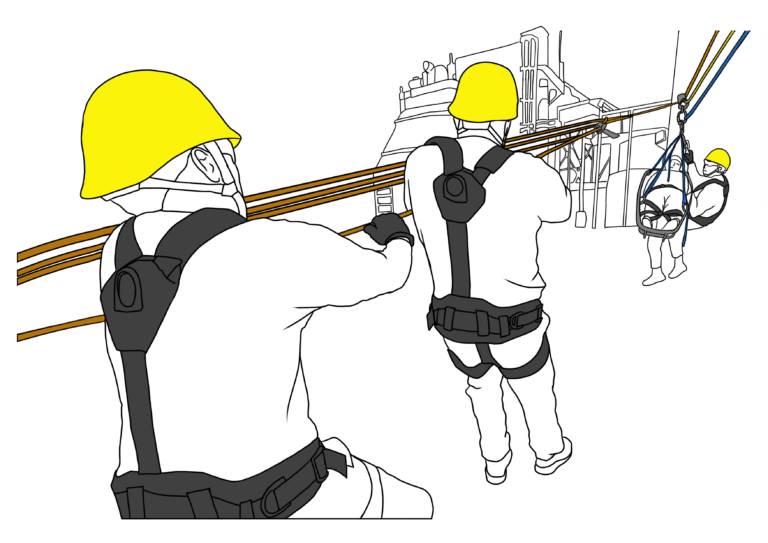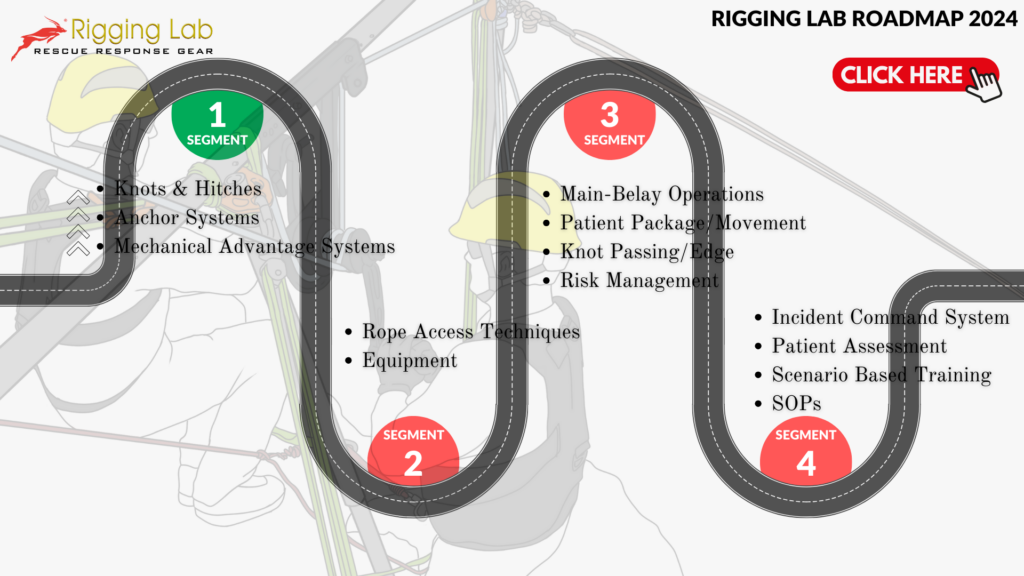Effective rescue operations often require the use of raising and lowering systems to safely move individuals and equipment. Understanding mechanical advantage systems is crucial for performing these tasks efficiently and safely. This super blog will guide you through comprehensive learning modules focused on raising systems and mechanical advantage (MA) systems, with cross-references to essential hardware from Rescue Response Gear.
Module 1: Introduction and Objectives
1.1 Raising and Mechanical Advantage Learning Objectives
The primary goal of this module is to provide a thorough understanding of raising systems and mechanical advantage in rescue operations. By the end of this module, you will be able to:
- Grasp the basic principles of mechanical advantage.
- Differentiate between simple, compound, and complex pulley systems.
- Apply appropriate mechanical advantage systems in various rescue scenarios.
- Set up and operate raising and lowering systems effectively.
For more detailed information, explore the comprehensive Rigging Lab Academy training resources.
Module 2: Mechanical Advantage Overview of Content
2.1 Pulleys and Mechanical Advantage in Brief
Pulleys are integral to mechanical advantage systems. They facilitate the lifting and lowering of loads by redistributing weight across multiple points, thereby reducing the physical effort required. This section will cover:
- Pulley Mechanics: Understanding how pulleys reduce effort through force redirection.
- Types of Pulleys: Differentiating between fixed pulleys, movable pulleys, and compound pulley systems. Key pulleys available at Rescue Response Gear include the Petzl Pro Traxion and CMC MPD Pulley.
2.2 Simple vs Compound vs Complex Pulley Systems
- Simple Systems: Utilize a single pulley to redirect the force, providing a 1:1 mechanical advantage. These systems are straightforward but offer limited mechanical advantage. Examples of high-quality single pulleys are the Petzl Rescue Pulley and the CMC Rescue Pulley.
- Compound Systems: Combine multiple pulleys to create a greater mechanical advantage. Examples include the 3:1 and 5:1 systems, which allow for easier lifting of heavier loads. The CMC Double Pulley and the Petzl Twin Pulley are ideal for such setups.
- Complex Systems: Integrate both simple and compound systems, often incorporating additional components like piggyback systems, to achieve even greater mechanical advantage. The Petzl Jag System and CMC ProSeries Pulley are perfect for complex configurations.
For more detailed insights, visit the Raising and Lowering Systems blog at Rigging Lab Academy.
2.3 Piggyback Systems
Piggyback systems are advanced setups that involve attaching one mechanical advantage system to another. This configuration significantly increases the lifting capacity and is useful in scenarios requiring high-effort lifting with minimal physical strain. The Petzl Jag System and CMC Rescue MPD are excellent choices for these systems.
Module 3: Mechanical Advantage Considerations
3.1 Nine Considerations During Rescue and Rigging Operations
When setting up and operating mechanical advantage systems, it’s essential to consider the following factors to ensure safety and efficiency:
- Load Weight: Accurately assess the weight of the load to determine the appropriate mechanical advantage system.
- Anchor Points: Ensure anchor points are secure and capable of bearing the load.
- Pulley Efficiency: Use high-quality pulleys to reduce friction and increase efficiency. The Petzl Pro Traxion and CMC MPD are designed for optimal performance.
- Rope Quality: Ensure ropes are in good condition and appropriate for the load and conditions. High-quality ropes like the CMC Static Pro Lifeline and Petzl Parallel Rope are recommended.
- System Complexity: Choose a system that matches the team’s skill level and the operational requirements.
- Environment: Consider environmental factors such as weather, terrain, and space constraints.
- Safety Margins: Incorporate safety margins to account for potential load increases or unexpected stresses.
- Communication: Maintain clear communication among team members throughout the operation.
- Backup Plans: Always have contingency plans in case the primary system fails.
For further details, explore Mechanical Advantage Considerations.
Module 4: Powered Systems
4.1 Capstan Winches
Capstan winches are mechanical devices that use a rotating drum to wind and unwind ropes, providing a powerful and controlled means of raising and lowering loads. This section covers:
- Introduction to Capstan Winches: Basic principles and operation of capstan winches.
- Applications: Common scenarios where capstan winches are used in rescue operations.
- Safety Considerations: Best practices for safe operation, including load limits and operator training. The Portable Capstan Winch and the CMC CLUTCH from Rescue Response Gear are excellent choices for rescue operations.
Module 5: Set-Up of Mechanical Advantage Systems
5.1 1:1 System with Ratchet
A simple setup using a single pulley and a ratchet mechanism to secure the load. This system is easy to set up and operate but offers limited mechanical advantage. The Petzl Rescue Pulley and CMC Rescue Pulley are ideal for this configuration.
5.2 3:1 Systems
Utilize multiple pulleys to create a 3:1 mechanical advantage, reducing the effort needed to lift the load by a third. This setup is ideal for medium-weight loads and offers a balance between simplicity and efficiency. The Petzl Partner Pulley and CMC ProSeries Double Pulley are reliable choices.
5.3 5:1 MA Systems
Further reduce the effort required to lift heavy loads by using additional pulleys to create a 5:1 mechanical advantage. This system is suitable for heavier loads and more complex rescues. The CMC MPD Pulley and Petzl Pro Traxion are highly recommended for such setups.
5.4 4:1 MA System with Double Pulleys
This setup uses double pulleys to achieve a 4:1 mechanical advantage, making it easier to lift and lower loads while maintaining control and safety. Consider the CMC Double Pulley and Petzl Twin Pulley for this configuration.
5.5 9:1 MA System
A highly efficient system that significantly reduces the physical effort required to move heavy loads. This setup is complex but provides substantial mechanical advantage, making it ideal for challenging rescue scenarios. The Petzl Pro Traxion and CMC MPD can be vital components in this system.
5.6 5:1 Complex MA System
Combines multiple pulleys and configurations to create a 5:1 mechanical advantage with added stability and control. This system is used in advanced rescue operations where precision and efficiency are critical. The Petzl Jag System and CMC Rescue Pulley are perfect for such complex setups.
5.7 6:1 Compound MA System
Uses compound pulley configurations to achieve a 6:1 mechanical advantage, offering a high degree of efficiency and control for lifting and lowering operations. Key components for this system include the Petzl Pro Traxion and the CMC MPD.
5.8 2:1 MA System
A basic setup that provides a 2:1 mechanical advantage, suitable for lighter loads and straightforward operations. This system is easy to set up and requires minimal equipment. Recommended pulleys include the Petzl Partner Pulley and the CMC Rescue Pulley.
5.9 4:1 Compound MA System
A compound system that provides a 4:1 mechanical advantage, balancing efficiency and complexity for medium-weight loads. For this configuration, use the Petzl Twin Pulley and the CMC Double Pulley.
5.10 Mini Tip – The Z Rig Method
The Z Rig is a versatile and efficient setup that provides mechanical advantage by utilizing a zigzag configuration of pulleys and ropes. This method is useful for various rescue scenarios due to its simplicity and effectiveness. For setting up a Z Rig, the Petzl Jag System and CMC Rescue Pulley are ideal.
Conclusion
Mastering raising systems and mechanical advantage in rescue operations requires a thorough understanding of pulley mechanics, system configurations, and safety considerations. By following the structured modules and leveraging resources from Rigging Lab Academy and essential gear from Rescue Response Gear, you can enhance your skills and ensure effective and safe rescue operations.
For more detailed training and courses, visit Rigging Lab Academy.
Stay updated with the latest rescue techniques and training modules by subscribing to our newsletter and visiting our website regularly.










